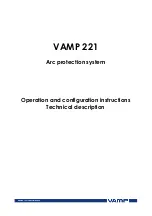
Functions
2.1 General
SIPROTEC, 7SD80, Manual
E50417-G1140-C474-A1, Release date 09.2011
29
2.1.1.2
Setting Notes
Setting the Scope of Functions
Your protection device is configured using the DIGSI software. Connect your personal computer either to the
USB port on the device front or to port B on the bottom side of the device depending on the device version
(ordering code). The operation via DIGSI is explained in the SIPROTEC 4 System Description.
The
Device Configuration
dialog box allows you to adjust your device to the prevailing system conditions.
Password no. 7 is required (for parameter set) to change configuration parameters in the device. Without the
password you can only read the settings but not edit and transmit them to the device.
Special Settings
Most settings are self-explaining. The special cases are described in the following.
If you want to use the setting group change function, set address
103
Grp Chge OPTION
to
Enabled
. In this
case, you can select up to four different groups of function parameters between which you can switch quickly
and conveniently during operation. Only
one
setting group can be used when selecting the option
Disabled
.
The differential protection function
87 DIFF.PROTEC.
(address
112
) as a main function of the device should
always be
Enabled
. This also applies to the supplementary functions of the differential protection such as
breaker intertrip.
The external trip initiation (address
122
DTT Direct Trip
) is a command that is initiated from an external
device for tripping the local circuit breaker.
At address
126
Back-Up O/C
, you can set the characteristic group which the time overcurrent protection uses
for operation. In addition to the definite-time overcurrent protection an inverse-time overcurrent protection can
be configured that either operates according to an IEC characteristic (
50(N) 51(N) IEC
) or to an ANSI char-
acteristic (
50(N) 51(N)ANSI
). This selection is independent of whether the time overcurrent protection is in-
tended to operate as emergency protection (only in case of protection communication failure) or as indepen-
dent backup protection. Device versions equipped with directional overcurrent protection (MLFB position 14 =
R or S) additionally provide a directional definite time overcurrent protection element and a directional inverse
time overcurrent protection element. The characteristic curves of the two inverse time overcurrent protection
elements are identical. The different characteristic curves are shown in the Technical Data (Section 4.6). You
can also disable the time overcurrent protection (
Disabled
).
Set to
Disabled
, the entire time overcurrent protection can be disabled.
For overload protection you can define in address
142
49
whether the function is to be
Enabled
or
Disabled
.
In address
139
you can set the breaker failure protection to
Enabled
or
Disabled
. The setting option
enabled w/ 3I0>
subjects the ground current and the negative sequence current to a plausibility check.
If the device features an automatic reclosing function, address
133
and
134
are of importance. Automatic re-
closure is only permitted for overhead lines. It must not be used in any other case. If the protected object con-
sists of a combination of overhead lines and other equipment (e.g. overhead line in unit with a transformer or
overhead line/cable), reclosing is only permissible if it is ensured that reclosing will only be performed in the
event of a fault on the overhead line. If no automatic reclosing function is desired for the feeder at which 7SD80
operates, or if an external device is used for reclosure, set address
133
79 Auto Recl.
to
Disabled
. Or
you can enter the number of desired reclosing attempts there. You can select
1 AR-cycle
or
2 AR-cycles
.













































